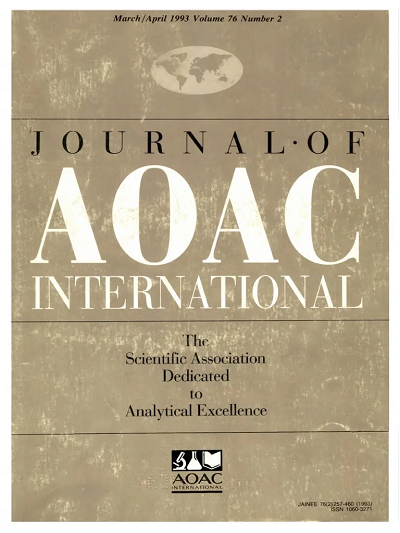Quality evaluation of gentamicin sulfate reference standards in Japanese Pharmacopoeia using hydrophilic interaction chromatography combined with tandem mass spectrometry
IF 1.7
4区 农林科学
Q3 CHEMISTRY, ANALYTICAL
引用次数: 0
Abstract
Background Through the recent development of analytical technology, antibiotics quantification in the Japanese Pharmacopoeia (JP) has changed from traditional microbiological assays to physicochemical methods with high specificity and precision. However, for several multicomponent antibiotics without typical UV absorption, potency cannot be directly determined using instrumental methods such as high-performance liquid chromatography; therefore, traditional microbiological assays are still used. Gentamicin sulfate (GmS), which consists of three major components, C1, C1a, and C2, is such a typical antibiotic, and its antimicrobial potency continues to be assayed using microbiological methods in JP monographs. Introduction of physicochemical assay for GmS is needed to help ensure its quality and quantity. Objective This study aimed to develop quality control measures for GmS that could be complimentary to quantitative assays and purity tests specified in the JP. Methods For each gentamicin C component (C1, C2, and C1a), theoretical potencies were determined based on the quantitative relationship between purity and potency, as measured by quantitative 1H NMR and microbiological assays, respectively. Two lots of the JP reference standard (RS) were used as test samples, with the contents of each component and impurity (sisomicin and garamine) being determined using hydrophilic interaction liquid chromatography-tandem mass spectrometry (HILIC-MS/MS). Results The ratios of theoretical potency for C1, C2, and C1a were 1.00, 1.21, and 1.80, respectively. The potencies of the GmS JP RSs, which were estimated based on the contents and theoretical potency of each C component, corresponded well with those determined through microbiological assays. Marked differences in impurities (%) between the two RS lots were highlighted by quantifying sisomicin and garamine. Conclusion The developed analytical procedure enabled the characterization of two different JP RSs in terms of content ratio, potencies, and impurities. Highlights Novel analytical procedures useful for routine quality control of GmS were developed using HILIC-MS/MS.利用亲水相互作用色谱法结合串联质谱法对日本药典中的硫酸庆大霉素标准物质进行质量评估
背景 随着近年来分析技术的发展,日本药典(JP)中的抗生素定量方法已从传统的微生物测定法转变为具有高特异性和高精确度的理化方法。然而,对于一些没有典型紫外线吸收的多组分抗生素,无法使用高效液相色谱等仪器方法直接确定其效价,因此仍在使用传统的微生物测定法。由 C1、C1a 和 C2 三种主要成分组成的硫酸庆大霉素(GmS)就是这样一种典型的抗生素,其抗菌效力在 JP 各论中仍采用微生物学方法进行测定。有必要引入 GmS 的理化检测方法,以帮助确保其质量和数量。本研究旨在制定 GmS 的质量控制措施,以补充 JP 中规定的定量测定和纯度测试。方法 根据定量 1H NMR 和微生物检测法分别测定的纯度和效价之间的定量关系,确定每种庆大霉素 C 成分(C1、C2 和 C1a)的理论效价。以两批 JP 标准物质(RS)作为测试样品,使用亲水作用液相色谱-串联质谱法(HILIC-MS/MS)测定各成分和杂质(西索米星和加拉敏)的含量。结果 C1、C2 和 C1a 的理论药效比分别为 1.00、1.21 和 1.80。根据每种 C 成分的含量和理论效价估算出的 GmS JP RS 效价与微生物检测确定的效价非常吻合。通过对西索米星和加拉敏进行定量,突出显示了两批 RS 之间杂质(%)的明显差异。结论 利用所开发的分析程序,可以对两种不同的太平绅士 RS 的含量比率、效力和杂质进行鉴定。亮点 利用 HILIC-MS/MS 开发出了适用于 GmS 常规质量控制的新型分析程序。
本文章由计算机程序翻译,如有差异,请以英文原文为准。
求助全文
约1分钟内获得全文
求助全文
来源期刊

Journal of AOAC International
医学-分析化学
CiteScore
3.10
自引率
12.50%
发文量
144
审稿时长
2.7 months
期刊介绍:
The Journal of AOAC INTERNATIONAL publishes the latest in basic and applied research in analytical sciences related to foods, drugs, agriculture, the environment, and more. The Journal is the method researchers'' forum for exchanging information and keeping informed of new technology and techniques pertinent to regulatory agencies and regulated industries.
 求助内容:
求助内容: 应助结果提醒方式:
应助结果提醒方式:


